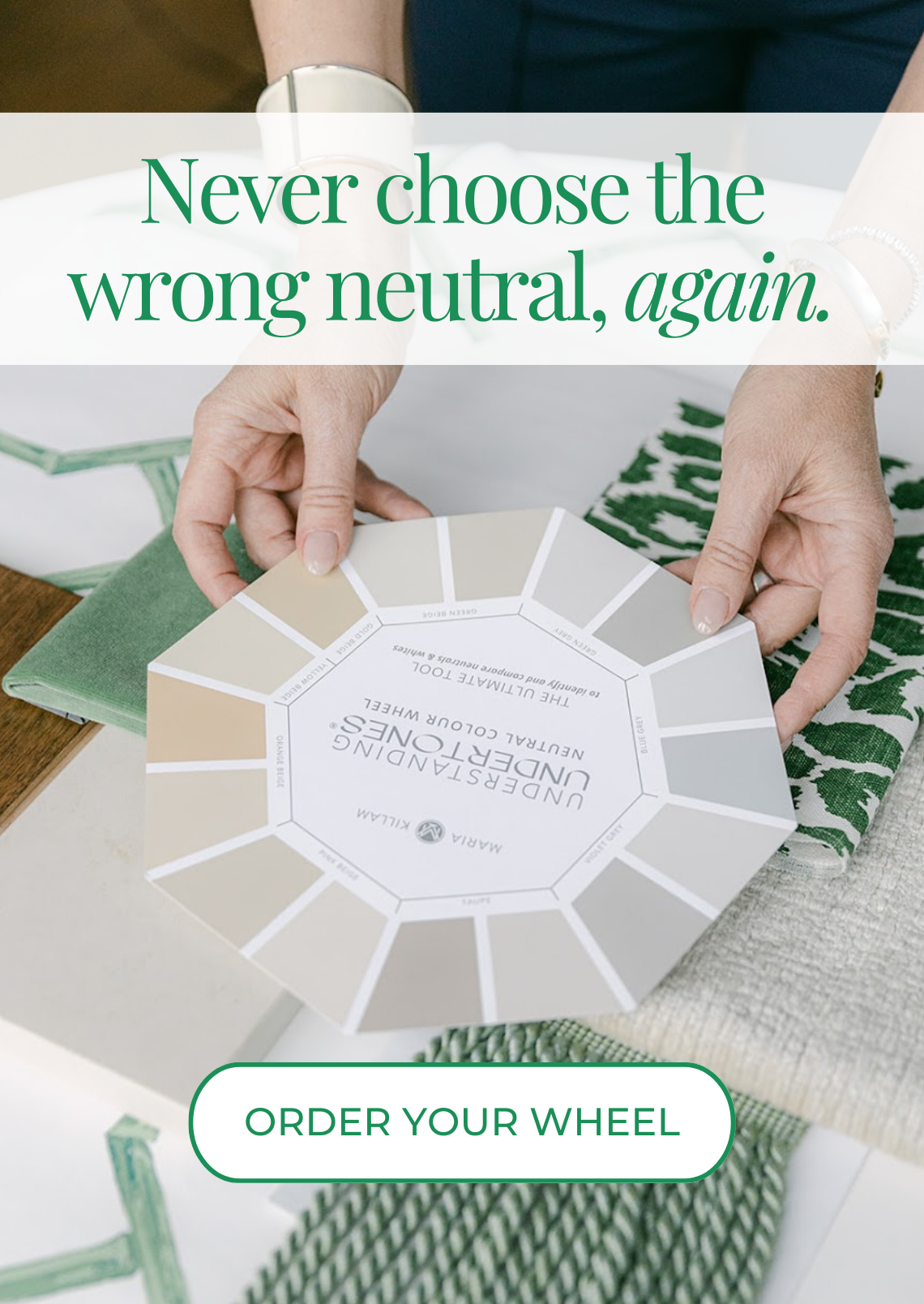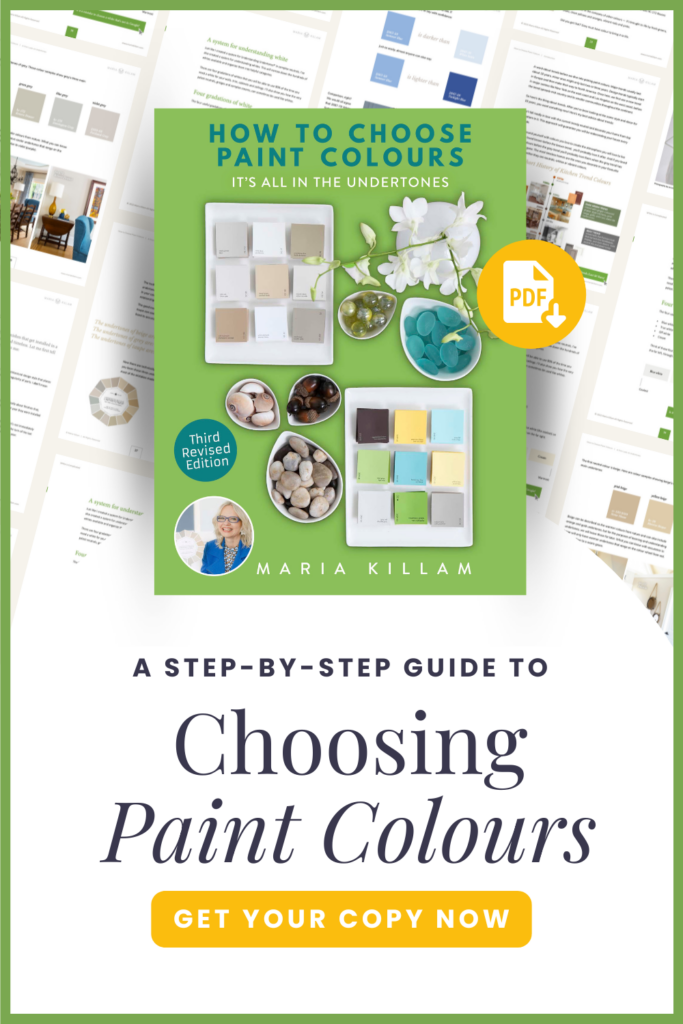This post is for anyone in the business of specifying colour. And the question is: “Should you pay for a room to be re-painted if the colour you recommended either looked terrible when the room was done or the client simply didn’t like it?” This was the question posed by the wonderful bloggers at The Skirted Roundtable this week. Having completed hundreds of colour consultations in my design career, I thought I would share with you, how I handle the colour testing/re-painting conversation:
First some background; the first course I took on colour was at the Daystudio in San Francisco taught by Joanne Day. She is a colour expert (in the business 35 years) who, upon choosing colours for her clients, paints 5 ft x 5 ft colour samples on boards, takes them to the clients home and asks them to live with it for a few days, view the colour in the morning light, noon and in the evening to make sure that they love the colour (obviously her rate covers the time to do this). As Joanne said “Sometimes a client hates the way it looks in the morning but if this is a room they spend most of their evenings in, and they love it at that time of day, then it is the right colour”.
 colour testing in the Orpheum
colour testing in the OrpheumThat was at the beginning of my colour and design career and since then I have always included this paragraph in my colour specifications to my clients which is headlined;
Recommendations for Perfect Colour;
“Maria Killam Colour & Design strongly recommends testing each colour chosen for each individual room with a 5 ft by 5 ft painted sample. Lighting, exposure of the room, your own personal likes and dislikes will heavily dictate what happens to the colour once it is painted in the room. Should you decide not to test each paint colour in every room of your house (as this can be just as expensive as re-painting just one room), be prepared to paint one or two rooms over again as I cannot predict with 100% accuracy that the colour will be perfect every time.”
It is our job as designers to guide our client with the correct colour suggestions however, there is no way a colour consultant can or should take responsibility for a paint colour gone wrong because it is impossible for anyone to predict in advance whether the client will even like the paint colour once they see it painted on the walls not to mention the way the colour changes in the room with the different lights of the day as well. Which is why colour should always be tested first.
The other part of our job as designers, is managing our clients expectations on the wonderful nuances and frustrations of colour (some houses, especially rooms without direct sunlight, or filtered light, can be the most challenging) I had one client who painted one wall in her kitchen 11 times before she hired me (she had painters in her house for 2 months). Colour that goes wrong is very upsetting because it creates a feeling besides the fact that suddenly it doesn’t work with your furniture, etc. Therefore, if your client is committed to having colour in their house (which is more and more, the way people are decorating now) they need to be prepared to practice due diligence with colour testing.
Some designers (once they have palettes picked out for an entire house) do not let the client see the colour until it’s complete (going back to the colour must be seen in context post I just wrote a few days ago) and if you are decorating a house from top to bottom, sometimes this is a good strategy. Especially when the painter is in house and the colour is going up, because a lot of people have a hard time visualizing, that’s why they have hired us in the first place. I read somewhere that Jamie Drake once said “I don’t have problems with colour, I pick the colour, and it’s perfect every time” certainly easier to do when you actually are specifying every detail in an entire house. One of the best comments on the post I wrote about ‘hiring a designer’ was “Hire a professional for everything you can’t do professionally yourself”, it’s just the smart thing to do.
However, if you have strictly been hired to pick a colour palette that flows through the house for the client, testing is especially crucial at this stage, with colour being selected to work with existing finishes in the home.
To make sure the undertones in your home coordinate, get some large samples!
If you would like to learn to choose the right colours for your home or for your clients, become a True Colour Expert.
If you would like your home to fill you with happiness every time you walk in, contact me.
Related posts:
Insider Secrets to Testing & Selecting Paint Colours
5 Questions to consider when selecting a new colour for your kitchen
The right way to create flow using colour
Effect of Natural Light Exposures on Colour






















you never fail to amaze me with your posts! i have a post saved just for you! i was planning on posting it next monday or tuesday, keep a look out
funny… sometimes i think i should have become an interior designer instead of a graphic communications one. i remember when i first painted my living room, it took me over a week, maybe two, just to pick the right shade of sage green. i think i tried dozens of little baby swatches on my wall… waiting from morning to night to see it in every light… and i thought “i hope nobody notices how many sample chips i am stealing from the store” since i didn’t know this was “standard practice”. –– in the end i was very happy with my colour. (now i’m due for a new place with new colours!)
Great post Maria! have you considered writing a book??
Even if I was lucky enough to afford to work with a designer, I can’t imagine giving them carte blanche (sorry for the pun) to pick any color they wanted, and not see it until it was finished.
It makes sense to me that, whatever is chosen, the client approves it and lives with the results… or pays the cost of getting the rollers wet again.
Great tips and thanks for mentioning The Skirted Roundtable!
That part of the conversation stuck out to me, too. I tell clients I will do my best to help them visualize and we paint a section of wall for them to approve. Once they do, then THEY will pay for any repaints. If I get the feeling they are having that hard a time trusting me, then I may not go forward. Bottom line, do they know what they want or do they want me to guide them. I tell them that getting a little outside their comfort zone usually yields the best results. If they don’t, they are just going to get what they would have done without my help, and that is a waste of money.
great post. I just faced this with my client, you know the one. we painted it a color we both approved, it looked fine, but when it went on the walls- they just didn’t like the color! they paid to do it over to a more neutral shade. but, on their facade, she had me pick from a few tiny samples and when it when on – they had painted the window frames – I hated it and had them redo it. I would have paid for that mistake. but they didn’t ask me too. still, sometimes it’s just impossible to know for sure until it’s all painted. for me at least. i’ve made a mistake a few times – just a few, but those are the ones that stay in your mind.
Maria, you always share great information with us, priceless! I agree with Tiaa… a book is needed (just copying your Posts you have it ready to go to press)
In my last apartment I tried out maybe 4 different colors from Donald Kaufman on my walls first. In really big areas. It was expensive to do this since you have to order samples from New York, then order the paints and have them mixed locally, but I found the perfect color this way. It changed my life forever. I chose DK 19, an amazing gray-blue that everyone from the burly plumber to picky interior decorators commented on how great it was. I never regretted the money or effort of choosing wall color this way.
In my current apartment, I tried out 5 shades of color from Restoration Hardware and two Donald Kaufman, including the DK 19, in big areas on my walls. I assumed I’d go with the same color as before — the DK 19 — but the light is all from the north and so had a very different effect.
I ended up choosing Restoration Hardware’s Bay Laurel and it’s beautiful all day and beautiful all night.
Tiny swatches are only good for choosing ranges of colors to try on your walls.
Maria!
Great post. I always do lavish sampling with large samples. If not –they paint at their own risk.
There are rare times when it has to be massaged–we tint by the wall at times– in the same room…because of the light conditions we customize the same color per wall to make it look generally correct. If I don’t get that right…then I pay for it…literally.
But, agreed….get sign-off on everything and test lavishly…otherwise you can encounter ambiguity and ambiguity = trouble.
We all just want right action and satisfaction all around!
I couldn’t agree more, Maria.
I now make huge paint samples to look at in the actual space that is being painted. We look at the sample against each wall of a room and at different times of the day. Even doing this, there have been times when the color still doesn’t turn out quite right.
Sometimes it is hard to tell how the color is going to look when it is on all four walls. I have found that some colors change when they reflect upon themselves. Fortunately, this is a rare occasion!
Yes, managing expectations is key.
xo
Brooke
Thanks Maria for walking us through some difficult terrain. You can’t overlook the importance of sampling the color. The other element besides light, is context. It’s great to be able to see the wall color along with the furnishings and fabrics. Sometimes these help bring an otherwise “wrong” color into the fold.
Maria, thank you for another great post. When I painted our living room I had samples painted all over the place. The color from the can just was not cutting it so I kept adding a gray paint until I was happy. Only then did I have the paint custom mixed.
Just as with fabrics, paint should be looked at in all lights. I have seen fabrics that look great in the day but not at night and conversely great at night and not in day light. The old adage that if it looks great in sunlight it will look great at night is not always true.
I’ve always found one of the most frustrating aspects of decorating for others is the incomplete client review: that is, when they start freaking out and wanting to make changes before the room is complete. One of the most important skills a professional can have is the ability to calm clients down and convince them to wait until everything is complete before evaluating. 9 times out of ten, they love the completed look even if they don’t love every detail.
Southern Chateau nailed it for me, I absolutely agree. We had this discussion a couple of days ago and it still resonates with me.
I have clients right now, they seem not to trust and have very strong views by themselfs, so I do not push the envelope any further and rest my case. After all the client has to live with it. But I feel it is a shame after so much involvement to get a rather bland result.
If I select a color and the client is not happy or did not 100% agree, then I would pay for the change, usually I make sure before hand to have approval and we are happy with the try outs.
Have a lovely weekend, Maria!
XX
Victoria
Loved this discussion on The Skirted Roundtable and your post.
I have recently discovered that it is hard to look at a color when the old color is still on the walls. I have started priming first and then testing samples. It doesn’t cloud your view of the new colors or confuse them with the old color.
I tried nearly 25 samples in my living room – yellows, various whites, off-whites – in order to lighten it (while the old yellow was on the walls). But I finally stopped fighting the lack of light and painted it brown and I love it!
Also, a note on samples. I was at Home Depot recently and Ralph Lauren now has $5 samples of all colors. You can have them mixed right there. The only catch is you can only sample eggshell.
It took me awhile to like Ralph Lauren. You definitely have to use two coats to get the great depth of color.
What a refreshingly thoughtful, considered response to a true decorating dilemma. I love your drama-free approach to design, Maria.
It’s so definitely worth the added time and minimal cost to have large sample boards made…great advice!
Maria,
Such good advice, thanks. I am sitting on pins and needles with a client now who lives in northern Va, and I am in Georgia….we did large samples and she likes, the painter comes Monday and Tues…fingers crossed.
Blessings…
Great post! I’ve found it is often hard to tell ubtil that last bit is covered…it IS a four wall thing. I need to re-paint and am dragging my heels…big time!
Thanks Maria
This post is so informative, a pleasure to read with beautiful pictures.
I am especially drawn to the yellow dining room and that beautiful pear green back drop. Lovely and comforting.
Vitania
Hi Maria,
Your posts are always so informational. I love reading them, then rereading them. How funny about Jamie Drake, oh to be that confident! I also agree with your quote about hiring professionals to do things you could not do yourself professionally. Great post as always!
Great article. I tell clients all the time they need to have samples put up before they paint. They dont always want to invest in paint swatches but it makes all the difference
Right on the money with your thoughts, Maria.
As you advise, I always encourage customers to test a sample first.
While I can be relatively confident in my ability to match an inspiration item (art, rug, pillow, granite, etc), that doesn't always mean the customer will like the color when it goes up. It can look -and feel- different when you see a large expanse.
At least a poster board size is mandatory. And if you do paint the wall, try just a couple of colors first, leaving ample space between them. I've walked into rooms with 4 or 5 tiny squares slopped over each other. Who could possibly evaluate that?
I spec mostly Sherwin-Williams colors, and their color visualizer is a helpful tool to get you in the ballpark. The final decision, however, cannot possibly be made from a monitor, as Maria wisely counsels.
I paid for a repaint job job on a staging project this spring. Since I recommended the color, and had one shade darker in my own bedroom at home, I felt like I knew exactly how the color would work. What a shock to see where this particular color, which was a lovely shade of blue/green in my home, turned bright blue in their home!!! It had to be the light, as they had no direct sunlight in the room. I thought it was my responsibility to cover the cost of having the room repainted.